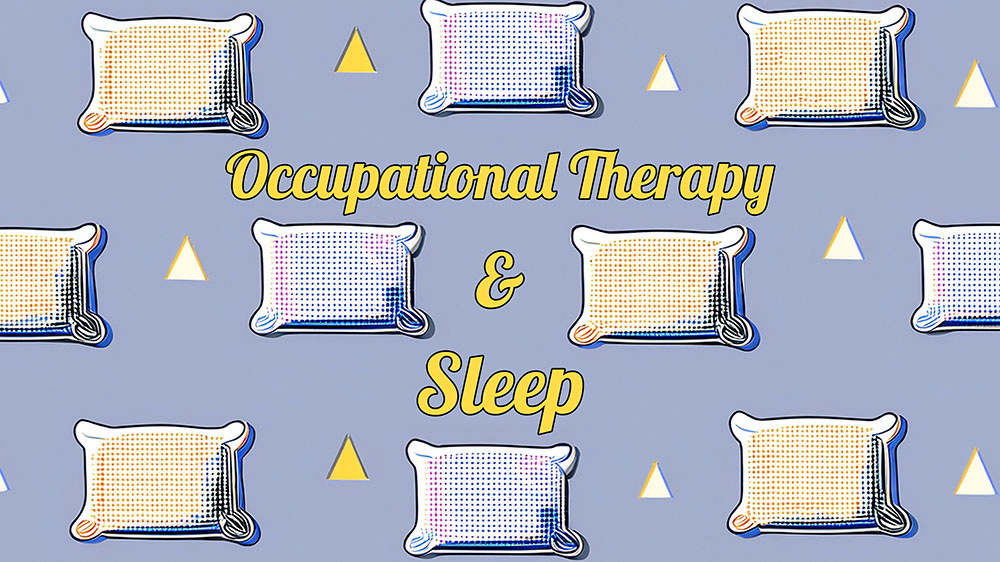If you are considering occupational therapy as a treatment for sleep difficulties, we want you to be as informed as possible—so we, as OTs, can truly partner to create the best course of treatment for YOU.
In occupational therapy, we tend to work from “menus” of evidence-based assessments and treatments. This gives us the flexibility to meet the specific needs of each patient. Below, you’ll find the assessment and treatment options your therapist may use, along with the evidence supporting them.
At the bottom of this page, you’ll find occupational therapists near you who can support you in addressing your sleep difficulties.
Please note that this page is for educational purposes and does not substitute advice from your medical provider.

A quick note on why to pursue occupational therapy for sleep difficulties
Occupational therapists view sleep as foundational to overall health and well-being.
Sleep is an area of health that has a direct impact on your ability to engage in all other occupations. Occupational therapists can play a vital role in helping individuals improve their sleep by addressing the factors that impact a person’s ability to fall asleep, stay asleep, and obtain restful sleep.
Unlike other, more invasive intervention options for sleep difficulties—such as prescription medications—occupational therapy focuses on healthy sleep habits and routines, environmental modifications, and stress reduction techniques that help promote more restful sleep.
Sleep difficulties impact a large percentage of the U.S. adult population, with 33% of Americans reporting their sleep as poor (Sleep Health, 2023). The estimated cost of insomnia in the U.S. is close to one billion dollars a year.
Therapy, on the other hand, costs around $100-$200 per session. Conservative treatments like occupational therapy—especially cognitive behavioral therapy for insomnia (CBT-I)—are considered the first-line intervention for insomnia, and they are highly effective in reducing sleep problems and improving sleep, health, and general well-being.
The benefits of quality sleep include improved:
- cardiovascular health,
- energy and mood,
- mental health,
- cognition,
- memory consolidation,
- immunity,
- reproductive health, and
- hormone regulation.
Therapist-recommended assessments for sleep difficulties
Occupational therapists assess individual sleep patterns, environments, and daily routines to identify factors contributing to a person’s sleep problems.
As you can see below, multiple different components can be involved in evaluating sleep difficulties. That’s partly because several areas of overall body function can be affected—especially within the context of your everyday life.
Assessments also serve as a point of comparison for tracking your progress and response to treatment over time. An accurate and thorough baseline allows your therapist (and you!) to discern how much the interventions are helping. Your therapist may perform certain assessments at various intervals over the course of therapy.
Members of the OTPotential Club can log in to see these assessments broken down in more detail.
Occupation-Focused Assessments:
- Canadian Occupational Performance Measure (COPM)1
- AOTA Occupational Profile
Sleep-Specific Assessments:
- Consensus Sleep Diary
- The Pittsburgh Sleep Quality Index (PSQI) 2
- The Insomnia Severity Index (ISI)
- The Epworth Sleepiness Scale
- Sleep Hygiene Index
- The Dysfunctional Beliefs and Attitudes About Sleep Scale (DBAS)
- Morning-Eveningness Questionnaire (MEQ)
Setting Goals for OT Sleep Interventions
Therapy works best when there is buy-in from the patient. It is important that you work with your therapist to set treatment goals that truly reflect what’s important to you.
Occupational Therapy Treatment Interventions for Sleep
After a thorough evaluation and goal-setting process, it is time to start making progress. Below are treatment interventions that can be implemented as part of a holistic therapy program.
Occupational therapists take a unique approach, considering intervention at the person, environment, and occupational level.
Possible Treatment Interventions 4,6
Person:
- Sleep diary tracking7
- Sleep physiology/circadian health education8
- Health management behaviors
- Positioning
- Energy conservation9
- Pain management
- Relaxation/mindfulness, coping skills, stress management7
- Sensory needs
- CBT-I7
Environment:
- Environmental modifications
- Education on sleep environment
- Sleep hygiene
- Sleep aids/adaptive equipment
- Limiting screen time/device exposure
- Sleep promotion education (including with caregivers/staff)
Occupation:
- Consistent sleep schedule
- Healthy, consistent daily habits and routines
- Wind-down/preparation for sleep
- Wake-up habits and routines
- Sleep-promoting occupations
Discharge Suggestions
Every person is unique, so your individual response to therapy will also be unique. We recommend that you:
- Continue to use health management and empowerment strategies to control any remaining symptoms.
- Follow recommendations/strategies for habit consistency, like using a habit tracker and adhering to routines post-discharge.
- Utilize active coping strategies and proactive problem-solving if sleep becomes disrupted again (e.g., due to stress).
Choosing an occupational therapist for sleep difficulties
If you are looking for an occupational therapy professional near you to help address your sleep difficulties, you can use the OT Near Me Directory below. We’ve highlighted the professionals who have tagged “Insomnia & Sleep” as a focus area.
Note that cognitive behavioral therapy for insomnia is a specific evidence-based approach with its own certification. Therapists who have this certification typically use the CBT-I credential.
Conclusion
Hopefully this article helped you understand what occupational therapy for sleep difficulties entails.
This article is updated once per month based on newly released research. If you have any research you would like us to consider, please drop it in the comments.
Therapists who would like more detailed information on sleep therapy best practices can join us as members of the OT Potential Club.

Article by
Amanda Carroll MS, PhD, OTR/L, is an experienced occupational therapist, educator, and PhD-trained occupational scientist. Amanda’s research focuses on the intersection of occupation, mental health, and social determinants of health, with a particular interest in veteran populations, sleep interventions, and rural health disparities.

Reviewed by
Sarah Lyon, OTR/L, is the CEO of OT Potential and is on a mission to bridge the gap between research and real occupational therapy practice.
Edited by
Brooke Andrus is the Head of Content at OT Potential, bringing over a decade of experience strategizing, building, and executing on content marketing plans for successful healthcare tech startups in the rehab therapy and behavioral health spaces.
References
Here’s the science backing the assessments and treatment outlined above.
- Law M, Baptiste S, McColl M, Opzoomer A, Polatajko H, Pollock N. The Canadian Occupational Performance Measure: An Outcome Measure for Occupational Therapy. Can J Occup Ther. 1990.
- Germain A, Hall M, Krakow B, Shear MK, Buysse DJ. A brief sleep scale for Posttraumatic Stress Disorder: Pittsburgh Sleep Quality Index Addendum for PTSD. J Anxiety Disord. 2005.
- American Occupational Therapy Association. Occupational Therapy Practice Framework: Domain and Process—Fourth Edition. Am J Occup Ther. 2020.
- Ho ECM, Siu AMH. Occupational Therapy Practice in Sleep Management: A Review of Conceptual Models and Research Evidence. Occup Ther Int. 2018.
- Baum C, Bass J, Christiansen C. Person-Environment-Occupational Performance (PEOP) Model. In: Christiansen C, Baum C, Bass J, eds. Occupational Therapy: Performance, Participation, and Well-Being. 4th ed. Slack; 2015.
- Green A, Brown C. An Occupational Therapist’s Guide to Sleep and Sleep Problems. Jessica Kingsley Publishers; 2015.
- Eakman AM, Schmid AA, Rolle NR, Kinney AR, Henry KL. Follow-Up Analyses From a Wait-List Controlled Trial of Occupational Therapist–Delivered Cognitive–Behavioral Therapy for Insomnia Among Veterans With Chronic Insomnia. Am J Occup Ther. 2022.
- Faulkner S. Sleep and occupational performance are inseparable: Why occupational therapy practice and research should consider sleep and circadian rhythm. Br J Occup Ther. 2022.
- Akbarfahimi M, Nabavi SM, Kor B, Rezaie L, Paschall E. The Effectiveness of Occupational Therapy-Based Sleep Interventions on Quality of Life and Fatigue in Patients with Multiple Sclerosis: A Pilot Randomized Clinical Trial Study. Neuropsychiatr Dis Treat. 2020.
Additional Resources:
- Faulkner S, Mairs H. An exploration of the role of the occupational therapist in relation to sleep problems in mental health settings. Br J Occup Ther. 2015.
- Leland NE, Marcione N, Niemiec SLS, Kelkar K, Fogelberg D. What is occupational therapy’s role in addressing sleep problems among older adults?. OTJR (Occup Ther J Res). 2014.
- Tester NJ, Foss JJ. Sleep as an occupational need. Am J Occup Ther. 2017.
OT Potential does not endorse any treatments, procedures, products, or therapists referenced herein. This information is provided as an educational service and is not intended to serve as medical advice. Anyone seeking medical advice should consult their medical provider.

